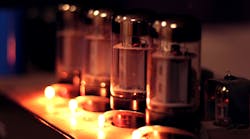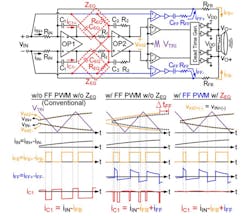This article is in TechXchange: Why Low Iq is the Smart Thing to Do
Members can download this article in PDF format.
What you'll learn:
- The benefits of using Class D amplifiers.
- What to look for when choosing a Class D amp.
- Making the tradeoff between THD+N and quiescent current.
Back in the day (1970s), audio amplifiers like the Phase Linear 700 were designed with discrete power-transistor components. Huge audio power transistors like the 2N3055 and others back then were configured to drive massive audio power outputs that drove large audio loudspeakers. Rock bands used to place dry ice on stacks of these legendary 350-W/channel amps to cool them down.
Fast forward to 2022 and we find audio design engineers loving the power efficiency of Class D amplifiers. The Class D amp outperforms any Class A, B, or AB linear amplifier architectures. With the latter amplifiers, significant power losses will occur due to biasing elements and the linear operation of the output transistors.
The Class D amplifier is used in audio circuitry as a switch that steers current to the audio load. Consequently, only a small amount of power is lost in the output stage.
Power losses, which are dissipated as heat, in a Class D amplifier are due to the output transistor’s quiescent-current overhead, switching losses, and on-resistance. Smaller heatsinks—even no heatsink—may be used in these amplifiers. Thus, Class D amplifiers are perfect for high-power, compact designs.
In the early years of design, the power-efficiency advantage of classical pulse-width-modulation-based Class D amps had been hampered by external filter component costs, EMI/EMC compliance difficulties, and poor total harmonic distortion plus noise (THD+N) performance when compared to linear amplifiers. Now, the latest generation of Class D amplifiers employ advanced modulation and feedback methods to mitigate these potential drawbacks.
Selecting a Class D Amp for a Design
When designers are looking for a Class D amplifier, they probably should begin with choosing the end-product features of their overall system design.1
Some key features might be loudness or output power and speaker/voice coil efficiency. There’s an industry standard for specifying the power level of an amplifier: the output power at 1% or 10% THD+N.
Next, designers need to select the number of channels at the selected power level. A standard power level in the audio industry is usually the output power level at either 1% or 10% THD+N. When specifying a power level, be sure to note if it’s peak or continuous power. Most likely, designs will be a stereo amplifier configuration, so two channels will need to be created.
Class D Amplifier Iq
The typical definition of quiescent current (Iq) is the current drawn by an integrated circuit (IC) in a no-load and non-switching, enabled condition. A further definition of Iq is the input current that’s consumed by an IC in many of its ultra-low-power states.
Used in battery-powered applications, which may spend a large amount of time in a standby or sleep mode, quiescent current can prolong a battery’s run time by years. A good example would be an ultra-low-Iq buck converter like the 60-nA TPS62840 to power an always-on application, such as in a smart meter application. In this case, it could enable 10 years of battery runtime.
Typically, Class D amplifiers will be designed into battery-powered applications. Examples in today’s electronics world are smartwatches or a smart lock for the home. Such designs will need:
- Low, always-on power for long battery runtimes that can be enabled via ultra-low-leakage process technologies and creative new control topologies.
- Fast response times for such things as fast wake-up comparators and zero-Iq feedback control. This will enable fast dynamic responses with no compromise on low power consumption.
- Reduced form factors, such as area reduction techniques for resistors and capacitors. This will be crucial for proper integration into space-constrained applications while not affecting the quiescent power.
Tradeoff: THD+N vs. Iq
In many designs, Class D audio amps typically employ a closed-loop topology using a loop filter, pulse-width modulator (PWM), and a switching power stage. This will help to suppress the linearity of the power stage to improve the THD+N.
If the designer chooses not to use a higher-order loop filter or a higher switching frequency (fSW), the PWM-residual-aliasing distortion introduced by the feedback loop will limit the minimum THD+N. Here, we now have a tradeoff between Iq and THD+N (see figure).2
The figure shows a proposed PWM-residual-aliasing reduction. This method is designed with a feedforward path (in blue) and a frequency-equalization block (ZEQ in red), which enables Class D amplifiers to lower their THD+N and Iq. The waveforms of a conventional, second-order, closed-loop Class D amp without the proposed technique are plotted at the bottom-left of the figure.
To cancel the high-frequency components from the feedback current (iFB), a feedforward current (iFF) is generated from the PWM that’s modulating Vin and gets added into the loop filter (bottom-center image of the figure). In addition, the PWM-residual-aliasing reduction with ZEQ becomes enabled (lower right side of the figure).
The PWM transition timing between iFF and iFB is aligned to eliminate the narrow pulses in iC1. This action further suppresses the aliasing distortion. Also, the absence of the narrow pulses in iC1 reduces the necessary bias current of OP1 (last stage in the figure), which will save the Iq.
Summary
The 1970s brought us excellent audio electronics solutions. Unfortunately, the size and power consumption of these devices were typically large and cumbersome. Still, they could produce good quality audio.
In today’s electronics world, quiescent current dominates audio applications. Audio device users want smaller, lightweight, but ultimately good audio devices. Enter Class D amplifiers, which are a key ingredient to making it happen, especially in portable and battery-powered designs.
This article demonstrated how to choose a Class D amplifier, with some specification tradeoff decisions. In the end, we find that it’s possible to have excellent audio performance with compact, lightweight designs that last longer than ever on a battery-operated power supply.
Read more articles in TechXchange: Why Low Iq is the Smart Thing to Do
References
1. “How to Choose a Class-D Audio Amplifier,” White Paper SLOA290, April 2020, Texas Instruments.
2. “A 0.41mA Quiescent Current, 0.00091% THD+N Class- D Audio Amplifier with Frequency Equalization for PWM-Residual-Aliasing Reduction,” ISSCC 2020 / Session 23 / Analog Techniques II / 23.5.
3. “Learning About Low Iq and Power Supplies,” Electronic Design

